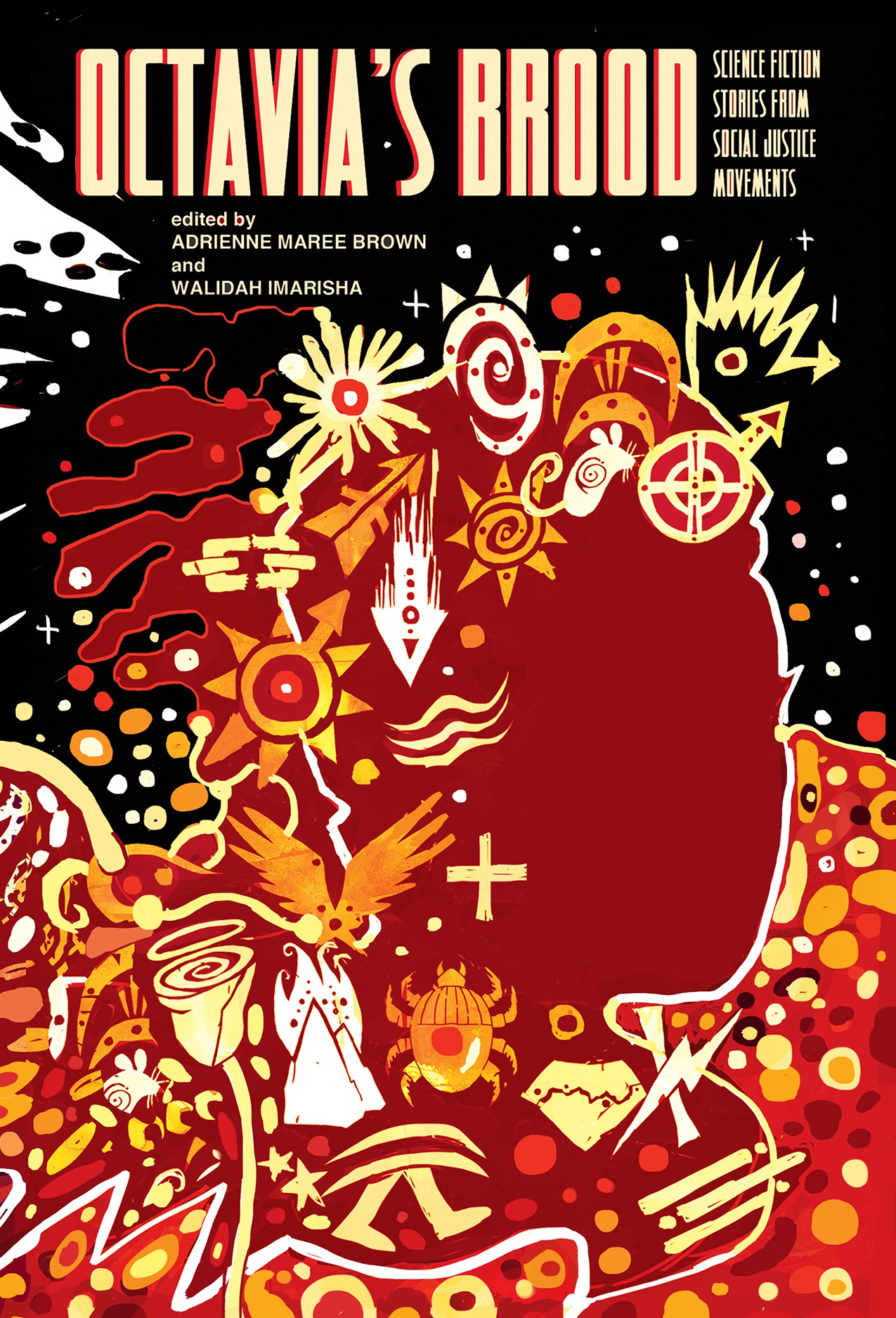This book review appears in the current issue of Perspectives on Anarchist Theory (N. 29, on anarcha-feminisms) available here, from AK Press.
Too often I find myself giving into the urgency of organizing, of how this struggle now takes priority over pausing, imagining, reorganizing, reorienting, creating and recreating new worlds, new ways of relating. Of course organizers everywhere are also, everyday, creating many other worlds within this one, but too often it feels as though what takes center-stage in our struggles are the analyses, critiques, and (of course) the too many, too long meetings that stand in for building something different. Spaces for risky, non-utilitarian creativity and inspiration are too often sidelined as inessential. Maybe the appearance of two sci fi books (both from radical presses whose mainstays are political non-fiction) suggests that sci fi is resurfacing as a relevant touchstone for contemporary political movements, signaling perhaps a bit more recognition of creative expression in explicitly political spaces. What exactly is the connection between sci-fi and radical movements and organizing? This question (and some ideas about how to answer it) emerged for me while reading these two humbling anthologies, which I’ll get to in a moment, but first, a little more about these books.

While Octavia’s Brood (2015, AK Press/IAS) and Sisters of the Revolution (2015, PM Press) appear initially as similar offerings from similar presses, their differences are quite profound. While both are compilations of overtly politically-engaged sci fi, the only near-overlap of content is that Sisters of the Revolution includes a brilliant story (one of the strongest in the collection) from the other book’s namesake, Octavia Butler. Beyond this, they both specifically include writers ‘on the margins’ of mainstream science fiction; in this way, many of the stories in each could be included in the other. The likening of one to the other is otherwise quite superficial, however, as the spirits that animate each anthology as a whole are clearly very different. Sisters is an historical compilation of pieces identified as “feminist speculative fiction” by its editors, Ann and Jeff VanderMeer, and seeks to bolster a feminist archive of science fiction, whereas Brood is “visionary fiction,” highly cultural production emerging from and meant to feedback into contemporary social justice struggles. Taken each as collections, they each task science fiction with a different function in contemporary politics, and in doing so fill very different niches, and leave the reader with different orientations towards social change and how it happens.
Sisters is an anthology of previously-published, short feminist speculative fiction, including works as old as Anne Richter’s 1967 “The Sleep of Plants,” and as recent as Rose Lemberg’s 2012 “Seven Losses of na Re.” The collection is well-stocked with award-winning pieces and authors, mostly published in the last thirty-five years. In quite a different spirit, Brood is a collection—gathered and edited by adrienne maree brown and Walidah Imarisha—of “social-justice” oriented work, mostly specifically written for this book: a grassroots project that eventually made its way to the Institute for Anarchist Studies (IAS) and AK Press. With a few exceptions the authors are first-time writers who brown and Imarisha requested contribute to the collection. That the book includes a short non-fiction piece by death-row prisoner Mumia Abu-Jamal and an essay by Tananarive Due on the theme of change in Butler’s work helps ground the political commitments of this collection.

Octavia’s Brood offers Octavia Butler as its namesake and “north star.” The late Octavia Butler, who died in 2006, was a firebrand independent Black feminist science fiction writer. She, while incredibly prolific, was among few mainstream-recognized Black women writers in this genre until recently. As Due outlines in her contribution to this volume, Butler not only wrote to help usher new worlds into this one, but also actively sought to have this world be one in which there were more Black sci-fi writers, more specifically Black women sci fi writers. This book project is testimony to this legacy and inheritance.
While it is clear that the editors revere Octavia Butler for her work, it is equally clear that she is not the sole progenitor of this book’s inspiration. As Imarisha convincingly insists in the Introduction, “all organizing is science fiction,” (3) and most of the pieces in this book were written by organizers. Clearly there are talented, creative people behind these stories, but more centrally, the spirit expressed in this collection is one of social engagement and collective change.
So Butler is a progenitor for this book, but so is struggle. As Imarisha notes, “for those of us from communities with historic collective trauma, we must understand that each of us is already science fiction walking around on two legs. Our ancestors dreamed us up and then bent reality to create us.”(5) This book emerges as small yet rich evidence of Imarisha and brown’s larger life projects of helping communities dream and bend realities themselves, together.
What stands out most prominently about the book, though, is that the worlds created in it are not dystopian dead-ends – or at least the characters won’t let them be that. Between the falling of the eponymous “Black Angel” created by Imarisha in her own contribution and the impossible choices faced by characters in Kalamu Ya Salaam’s “Manhunters” and Dani McCalin’s “Homing Instinct,” the heart of so many of these stories lies in the ways the characters struggle, and their choices to do so.
The stories in this book do not emerge as scathing critiques of contemporary society through tales of dystopian near-futures (though elements of that are certainly there) and they do not ask us to invest in a particular path towards utopia. Rather, the feeling I have after reading this compilation is that there are many ways to struggle, and it is perhaps in this that both meaningful lives and radical social change emerges. It avoids the traps that much politically-engaged science fiction falls into: diagnosing the ills of contemporary society to the degree that it becomes a trap without movement, with no way out. This trap, I think, is what the editors are creating an alternative to when they describe their project as not just science fiction but visionary fiction.
Certainly, this collection is not the most polished. The few excerpts from longer pieces are quite hard to follow, but – I must say – creatively and tantalizingly so: it is clear that they were not included to be comprehensive but instead be tastes of the larger works; regardless, they don’t flow easily alongside the rest of the collection. Beyond this, some of these works could be honed a little: we are often welcomed into elaborate worlds with different social structures and cultural norms without enough context to make them quite work in such a short space; additionally, as is the risk in science fiction, some of these stories come off as didactic. These shortcomings don’t take away from the strength of this work, which is not about perfect polish, but about ongoing processes and growth. It reminds me that these are written by people with stories bursting out of them, where there is never a final product, but always experiences, always processes, always another contribution to be made to create something different, something else, which in turn, will continue to change.
If Octavia’s Brood is the contemporary expression of the struggle to create new worlds from this one, Sisters of the Revolution is an anthology that asks us to remember some of the contexts from which sci fi, more broadly, has come.

This collection of already-published writing includes the tried and true Ursula K. Le Guin, James Tiptree, Jr., and Octavia Butler, but also creates space for the more contemporary and (as yet) less canonical Hiromi Goto, Nalo Hopkinson, and Vandana Singh. Under the broad umbrella of ‘feminist speculative fiction,’ this is a formidable and important archive of polished work, and is a solid introduction to some creative stories that engage the broad problematic of gender and patriarchy.
A feminist archive, however, will never be uncontroversial. From the perspective of mainstream science fiction, this compilation highlights voices and perspectives at its margins: it includes feminist voices spanning over fifty years. This creates a bit of a challenge for the collection: feminist movements of all stripes have radically changed how gender and sexuality is conceptualized (and lived) over this period – and whose experiences are reflected in those movements – but these changes are not tracked in this collection. If speculative fiction always has something to say about the present moment, but the work was written forty years ago, how do we read it now? And how do we read a collection of works written at different historical moments, in relation to different feminisms?
If there is, indeed, a singular feminism that emerges in this book, it is one very much in response to white-hetero-patriarchy. Many stories in Sisters of the Revolution reflect the bleakness of the potential future: the worst of this contemporary patriarchal society taken to an extreme. The stories that do this are sobering, angering, clarifying, and accurate in many ways. Critically, though, in creating bleak worlds with no way out, and without credible resistance, these stories often leave an aftertaste of despair that I personally read sci fi to avoid. There are other feminisms in here, however, from Nalo Hopkinson’s imaginatively and ambiguously resistant “The Glass Bottle Trick” to the enticingly geeky and happily-ever-after-esque “The Grammarian’s Five Daughters” by Eleanor Arnason, to Nnedi Okorafor’s inspiring “The Palm Tree Bandit,” in which movement and change is possible, creative and fun.
More critically, the feminism in many of these stories is one that conflates body parts, gender, and sexuality, especially in relation to men, but also for women in many stories. The most play happens at the level of gender, with women subverting femininity (LeGuin’s “Sur”) or sometimes just surviving in patriarchal societies taken to the allegorical extreme (Pamela Sargent’s all too prognostic 1984 “Fears”). Rather than drawing upon the diversity of experiences of gender in contemporary society, or using the wiggle room between binaries and norms as prying points for new ways of being in the world – and bringing on new ones – these stories too often fall back on essentialized notions of gender, and the ways out of dystopia are often about individual survival and womanhood. Given contemporary gender politics, this trajectory certainly makes this collection feel dated, and the archival anthology that it, well, is.
Seeing it as such an anthology allows for the older pieces to stand out for their historical significance in pushing the envelop of mainstream science fiction, and also for their lasting creativity and inspiration; Butler’s stellar 1987 “The Evening, the Morning, and the Night,” which plays with genetics and inherited traits in a somewhat deterministic yet allegorical way, is an excellent example of this. Additionally, the more recent pieces are clearly in this lineage: challenging what emerges as the mainstream in the book into a still different future for speculative fiction. Rachel Swirsky’s magical “Detours on the Way to Nothing,” and Vandana Singh’s innovative “The Woman Who Thought She Was a Planet” are some of the most creative contributions to the volume. In this new trajectory of feminist speculative fiction that the VanderMeers trace here, it is important to note that a significant number of the collected authors are women of color.
Read next to each other, Octavia’s Brood and Sisters of the Revolution make very different contributions. Brood builds momentum and inspiration for social justice movements that take the arts seriously – and vice versa – whereas Sisters contributes to a much needed archive of feminist struggles and visions, though many of these stories do feel narrow and dated in the age of Idle No More, Black Lives Matter, and radical queer & trans politics. It is also important to note the stark absence of Indigenous writers in both these compilations; it would have been nice to see the work of Zainab Amadahy, among others, highlighted here.

While reading these collections, what kept coming to mind is something that Indigenous folks, people of color, and disabled folks often remind others of us about with respect to mainstream (post-) apocalyptic fictions: some people have already lived and are currently living through the apocalypse, yet the worlds created in science fiction so often don’t include Indigenous folks, people of colour, people with disabilities. While again, Sisters is not absent women of colour, their contributions do not feel central to the feminism that emerges, in Brood this type of critique feels nearly implicit at its core: in fact, the radically subversive and clever “Hollow” by Mia Mingus does this with creative ease that does not feel like critique at all, but instead a welcoming. Brood feels like a welcoming, and opening to experiment and create new worlds not out of critique or shame, but desire to be a part of something more beautiful. What Imarisha notes in the Introduction to Brood, however, may help contextualize Sisters in this; she says, “changes will occur that we cannot even begin to imagine, and the next generation will be both utterly familiar and wholly alien to their parents.”(3) These books are odd relatives, indeed, though certainly not of the parent-child relation. Perhaps they are so alien to each other in many ways, but both necessary for the different roles they play.
Kim Smith is a cat-bicycle-book-resonance-machine. Trembling aspens and magpies speak to her from Edmonton/Papaschase Cree land in Victoria/Lekwungen Territories where she is holed up attempting to finish a Master’s degree.
The views expressed herein solely belong to the author(s) and are not necessarily representative of Perspectives on Anarchist Theory, the Institute for Anarchist Studies, or members of its Board of Directors.
